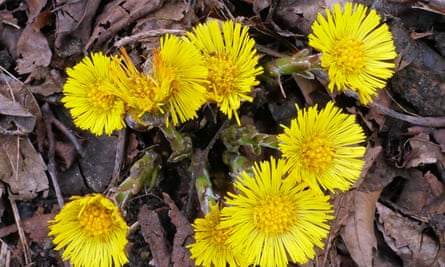Country diary: The colourful coltsfoot was once in great demand
April 11, 2025
On our way into town this morning we found coltsfoot blooming on the bank of the River Tyne, and when I noticed a jar of coltsfoot rock in the corner of the Hexham Sweetie Jar’s bow-fronted window, it seemed like an auspicious moment to investigate this herbal confectionery.
The sweets, shaped like miniature kerbstones, were flavoured with liquorice, so I still don’t know what raw coltsfoot medicine tastes like, but every herbal ever written extols coltsfoot’s therapeutic value for bronchial ailments; even its scientific name, Tussilago farfara, derived from the Latin for a cough, tussis, alludes to its use. John Gerard, in his Herbal of 1597, advised that “A decoction made of the greene leaves and roots … is good for the cough that preceedeth of the thin rheum”. And if that fails, put it in your pipe and smoke it: “the fume of the dried leaves taken through a funnell … burned upon coles, effectually helpeth those that are troubled with shortness of breath”, he wrote.

For past generations who depended on herbal remedies, before the days of antibiotics, big pharma and NHS prescriptions, spring was the beginning of the herb-harvesting year, testing plant identification and preservation skills. During the second world war, with no access to imported medicinal plant products from occupied Europe, schools, scout groups, Women’s Institutes, gardeners and botanists were mobilised to become herb-gatherers. By the end of the conflict, 250 herb-drying centres had been established.
An editorial in a 1940 issue of the Wild Flower Society’s magazine urged members to collect and send medicinal plants to Brome and Schimmer, a plant drug company that paid well per hundredweight of dried leaves: £3 (60/-) for lesser celandine, £3.50 (70/-) for dandelion and £4.50 (90/-) for foxglove. Some WFS members were unhappy, warning against making money “out of spoliation of our countryside”, fearing “wholesale destruction of much-loved wild flowers”.

Walking back along the Tyne, sucking my last piece of coltsfoot rock, I noticed fresh new leaves already appearing among its fading flowers. Eighty years ago, it would have required foresight, skill and hard work to harvest and dry enough for future winter ailments.
Search
RECENT PRESS RELEASES
Related Post



